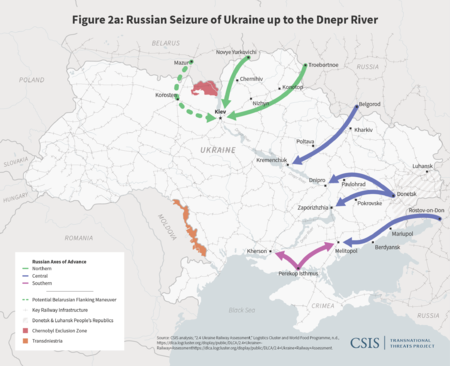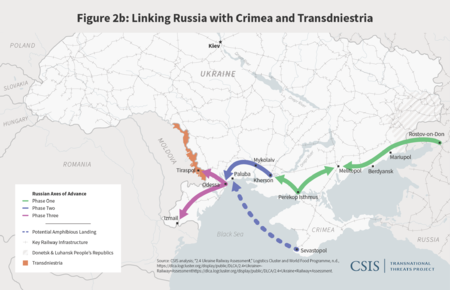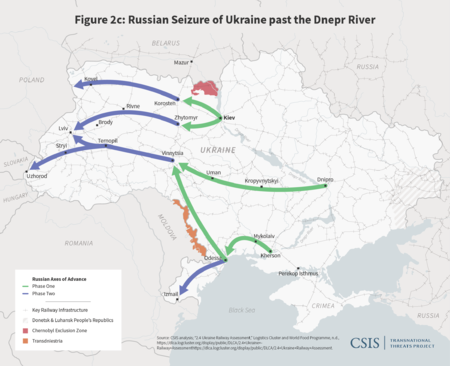2022 Russian invasion of Ukraine/Preparation
| Perpetrators | CIA, Ukraine, Russia |
|---|---|
| Description | A list of ways both sides prepared for the 2022 Russian Invasion of Ukraine. |
The 2022 War in Ukraine seemed to be one many prepared for.
Contents
NATO
In 2008, Russian president Vladimir Putin spoke out against Ukraine's potential accession to NATO.[1]
US
Dilyana Gaytandzhieva found that mid-2019 the US military was giving out contracts of a certain size for ammunition for Russian-made arms which are still widely in use in the former Soviet bloc; ammunition for assault rifles, pistols, sniper rifles and machine guns - as well as Grad rockets.[2]
Ukraine
On 14 September 2020, Ukrainian president Volodymyr Zelensky approved Ukraine's new National Security Strategy, "which provides for the development of the distinctive partnership with NATO with the aim of membership in NATO." On 24 March 2021, Zelenskyy signed the Decree No. 117/2021 approving the "strategy of de-occupation and reintegration of the temporarily occupied territory of the Autonomous Republic of Crimea and the city of Sevastopol.
Russia
In July 2021, Putin published an essay titled "On the Historical Unity of Russians and Ukrainians", in which he re-affirmed his view that Russians and Ukrainians were "one people". American historian Timothy Snyder described Putin's ideas as imperialism. British journalist Edward Lucas described it as historical revisionism. Other observers have described the Russian leadership as having a distorted view of modern Ukraine and its history.
Russian Planned Invasion
Back in 2014 Russia had contingency plans to do a full, or part scale invasion of Ukraine at the beginning the civil war, since it mobilised a sufficient number of troops and put specialised forces for the pacification of populations on notice (for possible deployment) - according to a RUSI analysis from April 2014 after the 2014 Ukraine coup installed a hostile government according to Russia.[3][4]
NATO expansion
| Russia's Putin: The US is parking missiles "on the porch of our house" - 2021 - Sky News |
- Full article: NATO
- Full article: NATO
With the end of the Soviet Union and the cold war, NATO expanded across several countries of the former Warsaw Pact. While it is now much closer to Russian borders, Mikhail Gorbachev as the leader of the SU at the time, received a lot of assurances from western leaders that nothing of the sort would happen; U.S. Secretary of State James Bakers famous “not one inch eastward”.[5][6] Some historians point to later comments by Gorbachev that: "The topic of ‘NATO expansion’ was not discussed at all",[7][8] but the memoranda of the 1990/91 period leave some doubt left what he was given by heads of state and special envoys.[5][9] With the following reign of Yeltsin, the US exploited the circumstances of a drunken president who was not really interested in the fate of his country and moved ahead with their plans, while telling the Russian side that the future European security system would include, not exclude them.[10]
“Russia behind the Headlines has published an interview with Gorbachev, who was Soviet president during the discussions and treaty negotiations concerning German reunification. The interviewer asked why Gorbachev did not “insist that the promises made to you [Gorbachev]—particularly U.S. Secretary of State James Baker’s promise that NATO would not expand into the East—be legally encoded?” Gorbachev replied: “The topic of ‘NATO expansion’ was not discussed at all, and it wasn’t brought up in those years. … Another issue we brought up was discussed: making sure that NATO’s military structures would not advance and that additional armed forces would not be deployed on the territory of the then-GDR after German reunification. Baker’s statement was made in that context… Everything that could have been and needed to be done to solidify that political obligation was done. And fulfilled.” Gorbachev continued that “The agreement on a final settlement with Germany said that no new military structures would be created in the eastern part of the country; no additional troops would be deployed; no weapons of mass destruction would be placed there. It has been obeyed all these years.” To be sure, the former Soviet president criticized NATO enlargement and called it a violation of the spirit of the assurances given Moscow in 1990, but he made clear there was no promise regarding broader enlargement.”
RBTH, Brookings (November 2014) [11]
Gorbachov himself disagrees - along with German historian Ignaz Lozo[12] - that he was lied to, but agrees that NATO was never meant to have expanded in this way.
In 2022, Russian president Vladimir Putin tried to halt the expansion of NATO by placing 100.000 troops at their Ukrainian border (which developed into the 2022 Russian invasion of Ukraine). Putin demanded the US to cease all NATO activity in every country joined since 1997.[13]
NATO Encircling Russia
- Full article: Encirclement of Russia
- Full article: Encirclement of Russia
Since the end of the Cold War [14] NATO is getting closer to Russia known as the encirclement of Russia. After increased militarisation and so called colour revolutions (backed by the establishment in NATO countries) in Eastern Europe, Russia was faced with a hostile regime in Kyiv, seeking NATO membership and military aid from NATO. Ukraine fell apart and three regions (Crimea and the Donbass) declared independance. One of those (Crimea) hosts a major Russian military base and port to the Black Sea at Sevastopol. Although 30% of the population speak Russian there, the use of the language was outlawed[15] by the Ukrainian government in Kyiv, which was at this time described as a US puppet regime. Kyiv's use of the Azov Battalion was deemed highly controversial but a third rail topic in western corporate media, calling the claims of Putin that he was fighting Nazis ludicrous. [16] This was seen as humiliation by Russia and Putin called for an "end to the Russian Genocide[17] in the Donbass", part of Russian propaganda to legitimize the invasion. In 2022, western media revealed the CIA had increased a secret U.S.-based training initiative for Ukrainian special operations forces and other intelligence personnel. That offensive division of the program, started somewhere around in 2015, also included instruction in firearms, camouflage techniques and covert communications.[18]
Military Scenarios
United States
The Washington D.C-based Center for Strategic and International Studies released a strategic paper on the 13th of January previewing the invasion.[19] The paper argued the US military to openly supply Ukraine with a "Twenty-First Century Lend-Lease Act" to provide Ukraine with war materiel at no cost and the CIA to plan and execute covert operations (ironically called "special operations" in the paper) while letting the Ukrainians stall for time.
“The Kremlin has at least six possible military options:
1. Redeploy some of its ground forces away from the Ukrainian border—at least temporarily—if negotiations are successful but continue to aid pro-Russian rebels in Eastern Ukraine.
2. Send conventional Russian troops into the breakaway regions of Donetsk and Luhansk as unilateral “peacekeepers” and refuse to withdraw them until peace talks end successfully and Kiev agrees to implement the Minsk Accords.
3. Seize Ukrainian territory as far west as the Dnepr River to use as a bargaining chip or incorporate this new territory fully into the Russian Federation. This option is represented in Figure 2a.
4. Seize Ukrainian territory up to the Dnepr River and seize an additional belt of land (to include Odessa) that connects Russian territory with the breakaway Transdniestria Republic and separates Ukraine from any access to the Black Sea. The Kremlin would incorporate these new lands into Russia and ensure that the rump Ukrainian statelet remains economically unviable.
5. Seize only a belt of land between Russia and Transdniestria (including Mariupol, Kherson, and Odessa) to secure freshwater supplies for Crimea and block Ukraine’s access to the sea, while avoiding major combat over Kiev and Kharkiv. This option is represented in Figure 2b.
6. Seize all of Ukraine and, with Belarus, announce the formation of a new tripartite Slavic union of Great, Little, and White Russians (Russians, Ukrainians, and Belarusians). This option would involve operations represented in Figure 2a as “phase one,” with Figure 2c representing “phase two” of this option.”
Center for Strategic and International Studies (13 January 2022) [20]
Although most western media outlets kept emphasizing the slow advance of the Russian troops, CSIS placed the speed into historial comparison; "Mechanized attacks are not always as rapid as attackers hope. Two of the quickest movements of armoured forces in history—German general Heinz Guderian’s punch through the Ardennes and seizure of Dunkirk in May 1940, and the U.S. and coalition advance from the Kuwait border to Baghdad in 2003—each averaged approximately 20 miles per day. Movement against a determined foe in winter conditions with limited daylight could reduce that rate of advance significantly." The cities of Kharkiv and Odesa are highlighted as the only cities to be required to seize until entering Kiev for logistic purposes, as the other cities would require an excessive amount of force, which would halt the armoured advance of the Russian troops.
CSIS also wrote "the initial attack will likely be well supported with artillery and air support, leading to several breakthroughs in Ukrainian defenses. However, once combat units expend their initial stores of ammunition, fuel, and food, the real test of Russian military strength will begin—including Russia’s ability to sustain the advance of a massive mechanized force over hundreds of miles of territory. Kiev and the Dnepr River crossings are at least 150 to 200 road miles from the Russian border, and its army will require at least several days of fighting to reach them. Before that, they will undoubtedly have to resupply, refuel, and replace combat losses of men and material at least once, which will require an operational pause."
The Ukrainian military command was advised to focus on halting Russian advance until thaw sets in and European countries openly ship better defensive weapons to the front lines and wait for economic sanctions to turn Russia bankrupt. The eerie consequence many Ukrainians would be slaughtered by a swift, and especially brutal Russian reaction to Ukrainian resistance was to be expected.
References
- ↑ https://en.wikipedia.org/wiki/2022_Russian_invasion_of_Ukraine#Post-Soviet_context
- ↑ https://armswatch.com/pentagon-buys-depleted-uranium-and-russian-made-ammunition/ saved at Archive.org
- ↑ https://www.rusi.org/explore-our-research/publications/commentary/rusi-briefing-examines-possible-russian-military-strategies-against-ukraine
- ↑ https://static.rusi.org/ukranian-military-dispositions-rusibriefing-2014.pdf
- ↑ a b https://nsarchive.gwu.edu/briefing-book/russia-programs/2017-12-12/nato-expansion-what-gorbachev-heard-western-leaders-early
- ↑ https://www.latimes.com/opinion/op-ed/la-oe-shifrinson-russia-us-nato-deal--20160530-snap-story.html
- ↑ https://www.brookings.edu/articles/did-nato-promise-not-to-enlarge-gorbachev-says-no/
- ↑ https://www.welt.de/geschichte/article237082635/Streitfall-Nato-Erweiterung-Gorbatschow-bestreitet-energisch-betrogen-worden-zu-sein.html
- ↑ https://libertarianinstitute.org/articles/not-one-inch-a-brief-look-at-the-written-record/
- ↑ https://nsarchive.gwu.edu/briefing-book/russia-programs/2018-03-16/nato-expansion-what-yeltsin-heard
- ↑ http://rbth.com/international/2014/10/16/mikhail_gorbachev_i_am_against_all_walls_40673.html Russia Behind the Headlines
- ↑ https://www.welt.de/geschichte/article237082635/Streitfall-Nato-Erweiterung-Gorbatschow-bestreitet-energisch-betrogen-worden-zu-sein.html
- ↑ https://www.bloomberg.com/news/articles/2021-12-17/russia-demands-nato-return-to-1997-in-security-treaty-proposals
- ↑ https://www.dw.com/en/nato-why-russia-has-a-problem-with-its-eastward-expansion/a-60891681
- ↑ https://web.archive.org/web/20210214235416/https://zakon.rada.gov.ua/laws/show/2145-19/page
- ↑ <https://en.wikipedia.org/wiki/Azov_Battalion
- ↑ https://tass.com/politics/1411067?utm_source=google.com&utm_medium=organic&utm_campaign=google.com&utm_referrer=google.com
- ↑ https://news.yahoo.com/exclusive-secret-cia-training-program-in-ukraine-helped-kyiv-prepare-for-russian-invasion-090052743.html
- ↑ https://www.csis.org/analysis/russias-possible-invasion-ukraine
- ↑ https://www.csis.org/analysis/russias-possible-invasion-ukraine Center for Strategic and International Studies


